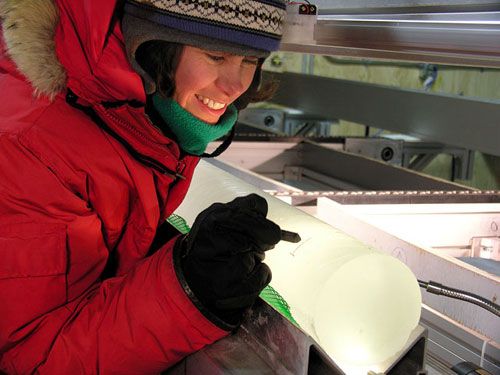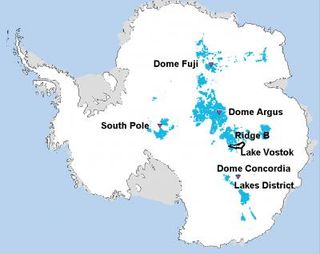
Regions of Antarctica could hold 1.5-million-year-old ice that would reveal key parts of Earth's ancient climate history, new research suggests.
The potential locations of the ice were described today (Nov. 5) in the journal Climate of the Past. One of those locations could allow scientists to drill miles-long sections of ice to explain why natural cycles in climate shifted about 1 million years ago.
Ancient air
Long cores of ice drilled from Antarctic ice can reveal clues to the planet's past climate, including the composition of air and temperature at the time.
"Ice cores contain little air bubbles and, thus, represent the only direct archive of the composition of the past atmosphere," lead author Hubertus Fischer, an experimental climate physicist at the University of Bern in Switzerland, said in a statement.
About 10 years ago, scientists drilled a 2-mile-long (3.2 kilometers) core of ice from Antarctica that revealed 800,000 years of the planet's climate history. Over that period, concentrations of heat-trapping greenhouse gases in the atmosphere, such as carbon dioxide, tended to rise with temperature. [Gallery: Scientists at the End of the Earth]
The research team wanted to go further back in time, to a period known as the Mid Pleistocene Transition, which occurred between 900,000 and 1.2 million years ago. Because of shifts in the Earth's orbit, the planet naturally goes through warmer and cooler periods. Prior to this transition, the Earth's cycles shifted every 41,000 years. Afterward, the Earth shifted to a 100,000-year cycle. Exactly why this occurred isn't known.
Sign up for the Live Science daily newsletter now
Get the world’s most fascinating discoveries delivered straight to your inbox.
Many scientists have proposed that a change in greenhouse gas levels in the atmosphere spurred this transition, but confirming that hypothesis requires climate data from the period.
Drilling candidates
The trouble is, finding clues to the past atmosphere is tricky, even in Antarctica, which has an extensive record buried deep in its ice, which has been relatively unchanged by forces like erosion.
As snow falls on the frigid continent, it slowly compacts and forms glacial ice. The weight of the ice sheet forces lower, older layers to spread out and become thinner over time. The oldest ice sits near the bedrock.
In theory, then, higher sheets of ice could potentially have an older climate history, because they posses more layers of ice stretching further back in time. But finding high sheets of ice isn't enough. When the ice gets too high, geothermal heating can melt the oldest layers of ice. And shifting bedrock can also jumble the annual layers of ice close to the bottom.
To identify the oldest Antarctic ice likely to yield good cores, the team used climate and ice condition data and modeled heat and ice flow on the continent.
The best locations to find such ice were near the bottom of East Antarctica at the Domes, the highest points on the ice sheet, as well as near the South Pole.

Now, researchers need to study ice thickness and temperature at the bottom of the sheet in those regions to find the best drilling location.
Follow Tia Ghose on Twitter and Google+. Follow LiveScience @livescience, Facebook & Google+. Original article on LiveScience.

Tia is the managing editor and was previously a senior writer for Live Science. Her work has appeared in Scientific American, Wired.com and other outlets. She holds a master's degree in bioengineering from the University of Washington, a graduate certificate in science writing from UC Santa Cruz and a bachelor's degree in mechanical engineering from the University of Texas at Austin. Tia was part of a team at the Milwaukee Journal Sentinel that published the Empty Cradles series on preterm births, which won multiple awards, including the 2012 Casey Medal for Meritorious Journalism.











